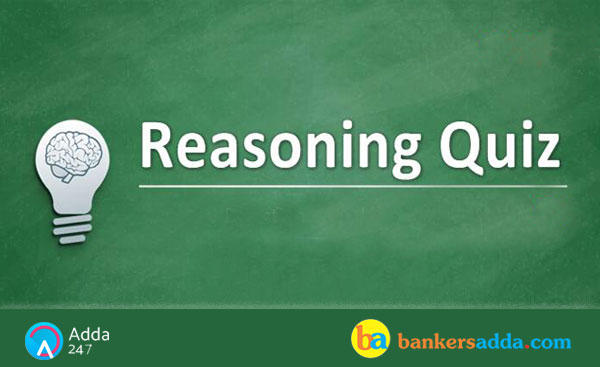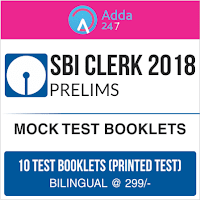Dear Aspirants,
Reasoning Ability is an onerous section. With the increasing complexity of questions, it becomes hard for one to give it the cold shoulder. The only way to make the grade in this particular section in the forthcoming banking exams is to practice continuously with all your heart and soul. And, to let you practice with the best of the latest pattern questions, here is the Adda247 Reasoning Quiz based on the exact same pattern of questions that are being asked in the exams.
Directions (1-5): Study the following information carefully and answer the given questions:
Twelve persons are sitting in two parallel rows containing six persons each in such a way that there is an equal distance between adjacent persons. In the Row-1 A, B, C, D, E and F are sitting and all of them are facing towards north. In the Row-2 L, M, N, O, P and Q are sitting and all of them are facing towards south direction but not necessarily in the same order. In the given seating arrangement each member sitting in a row faces another member of the other row.
O does not face E.Immediate neighbour of P faces B. M does not face D. Three persons sit between B and D. L sits second to right of Q. Only one person sits between L and P. P sits one of the extreme end of the line. D does not sit on extreme left end. Three persons sit between N and M. C sits second to right of F. C does not face L.
Q1. Who among the following sits between L and Q?
(a) M
(b) N
(c) O
(d) P
(e) None of these
Q2. Who among the following faces A?
(a) P
(b) Q
(c) L
(d) M
(e) O
Q3. Who among the following sits second to the left of B?
(a) A
(b) C
(c) No one.
(d) D
(e) E
Q4. How many persons sits between A and E?
(a) One
(b) Two
(c) Three
(d) Can’t be determined
(e) None of these
Q5. Four of the following five are alike in a certain way based on the given seating arrangement and hence form a group. Which is the one that does not belong to that group?
(a) P
(b) B
(c) N
(d) D
(e) E
Directions (6-7): Read the following information carefully and answer the given questions:
P + Q means P is the sister of Q
P # Q means P is the husband of Q
P $ Q means P is the daughter of Q
P % Q means P is the mother of Q
P @ Q means P is the brother of Q
Q6. What should come in place of the question mark, to establish that B is the child of K in the expression?
T % K # F % L + N ? B
(a) Only %
(b) Either + or @
(c) Only #
(d) Either @ or %
(e) Only +
Q7. Which among the given expressions indicate that J is the wife of F?
(a) P $ J % R + K % F
(b) F @ R + K + P % J
(c) J % P + K @ R $ F
(d) J % P # K + R + F
(e) None of these
Directions (8-9): Study the following information carefully to answer the given questions:
There are six persons viz. A, B, C, D, E and F of different ages. C is older than only A and E. D is younger than only B. E is not youngest. The one who is third oldest, age 81 year. E’s age is 62 years.
Q8. Which of the following could possible age of C?
(a) 70 years
(b) 94 years
(c) 86 years
(d) 61 years
(e) 81 years
Q9. Which of the following is true with respect to the given information?
(a) D’s age is definitely less than 60.
(b) F is oldest.
(c) Only two people older than C.
(d) There is a possibility that B’s age is 79 years
(e) None is true.
Q10. Mohan walked 40km towards North and then he took a left turn and walked 20km. He again took a left turn and walked 40km. How far and in which direction is he from the starting point?
(a) 20m west
(b) 20km North
(c) 20km South
(d) 100km South
(e) 20km west
Directions (11-13): These questions are based on the following set of numbers.
4384487737438833873338733837734783777374377833
Q11. how many 3’s in the above arrangement which is immediately preceded by even digit but not immediately followed by odd digit?
(a) One
(b) Three
(c) Two
(d) Four
(e) None of these
Q12. How many 7’s in the above arrangements which is immediately followed by perfect square?
(a) Four
(b) Three
(c) Two
(d) One
(e) None of these
Q13. Which of the following digit is 7th to left of 7th from right end in the above arrangements?
(a) 4
(b) 8
(c) 3
(d) 7
(e) None of these
Directions (14-15): These questions are based on the following six numbers.
643 741 285 579 792 428
Q14. If all the number are arranged from left to right in descending order then which of the following digit is in middle of the number which is second from the right?
(a) 4
(b) 8
(c) 9
(d) 7
(e) 2
Q15. If one is subtracted from third digit in each given number and then interchange the first and last digit then which of the following number is second highest?
(a) 643
(b) 741
(c) 579
(d) 285
(e) 428
You May also like to Read:
- More questions on Reasoning for Bank exam
- Reasoning ability study notes and tips
- SBI Clerk Mock Tests 2018




 Reasoning Quiz For Bank Foundation 2024 ...
Reasoning Quiz For Bank Foundation 2024 ...
 Reasoning Quiz For Bank Foundation 2024 ...
Reasoning Quiz For Bank Foundation 2024 ...



